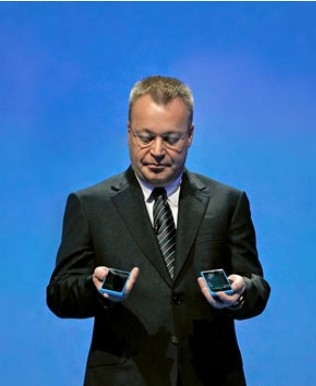
Business Nokia's new phones Not drowning, but waving
商業(yè) 諾記新機 懸崖邊的掙扎
The struggling phonemaker shows off its first Windows handsets
深陷泥潭的諾基亞展示自己的第一款微軟win7系統(tǒng)的手機.
EIGHT months ago Stephen Elop, Nokia's newish chief executive, told the Finnish phonemaker's staff that they were "standing on a burning platform" and had no choice but to jump into the "icy waters" below.
8個月前,斯蒂芬埃洛普,這位新晉諾基亞的首席執(zhí)行官,向這個芬蘭手機制造巨頭的員工發(fā)表了講話,說"我們正處于一個燃燒的平臺之中,別無選擇之下,只能跳入下方冰冷的海水中"。
His plan for fishing the company out of the freezing briny rests largely on making smartphones that use Microsoft's Windows operating system—and getting them to market quickly.
很大程度上,他將引領(lǐng)諾基亞走出低谷的希望寄托在了制造使用微軟操作系統(tǒng)的手機,并將其快速推向市場的計劃之上。
On October 26th Mr Elop unveiled the first of these devices.
在10月26日,埃洛普揭開了首批機型的面紗。
On a live feed from Salo, in Finland, a proud employee packed a Lumia 800 into its box.
在芬蘭薩羅的現(xiàn)場轉(zhuǎn)播中,一位驕傲的諾基亞員工將一部Lumia 800 裝進了包裝盒內(nèi)。
It is due to go on sale in six European countries next month. It will have a cheaper sibling, the Lumia 710.
此款機型計劃下個月在六個歐洲國家上市,并且它將有一個廉價姊妹版本----即Lumia 710.
By recent standards, this is fast work. Nokia had been slow to cotton on to the popularity of touch screens.
照現(xiàn)今業(yè)界的標準,之前對觸摸操控流行趨勢的反應遲鈍,但這次的行動確實迅速。
Its own operating system, Symbian, which was not designed for touch, looked clunky.
它的自家操作系統(tǒng),塞班,并沒有專門為觸摸操作而設計,而且看起來非常過時。
While Nokia dithered, consumers lapped up Apple's iPhone and the many smartphones based on Google's Android operating system.
當諾基亞正因此而站在十字路口猶豫時,許多顧客轉(zhuǎn)而選擇了蘋果的ipohone和基于谷歌安卓系統(tǒng)的手機。
All this cost Mr Elop's predecessor, Olli-Pekka Kallasvuo, his job in September 2010.
這就導致了埃洛普的前任Olli-Pekka Kallasvuo在2010年9月丟掉了工作。
Having plumped for Windows over Symbian and MeeGo, a system Nokia had worked on with Intel, a huge semiconductor-maker,
在下定決心選擇了微軟的系統(tǒng)而非塞班亦或是和半導體制造商英特爾合作開發(fā)的Meego系統(tǒng)之后,
Mr Elop has had to move quickly.
埃洛普先生必須要加速行動了,
Even fewer people want Symbian, though Nokia updates and supports it: Nokia's smartphone sales fell by 39% in the year to the third quarter, when the firm made its second quarterly operating loss in a row.
盡管諾基亞一直在為塞班系統(tǒng)提供升級和技術(shù)支持,但是想擁有一部塞班手機的顧客已經(jīng)越來越少了。今年,截至第三季度,諾基亞公司已經(jīng)連續(xù)兩季營業(yè)虧損,其智能手機的銷量下降了39%。
Pricing is another sign of urgency. The Lumia 710 will be the cheapest Windows smartphone available. It may be the first to be offered free to low-tariff customers after operators' subsidies, says Francisco Jeronimo of IDC, a research firm.
IDC研究公司的Francisco Jeronimo說道:"定價(的高低)也從另一個方面顯示了形勢的緊迫性。Lumia 710將是市面上最便宜的搭載WP7操作系統(tǒng)的手機,并有可能經(jīng)過運營商補貼之后免費提供給保稅區(qū)的顧客。
The new phones have more going for them than price and cool Nordic design. Operators will surely be glad of an alternative to Apple and Android.
這兩款新機的優(yōu)點不僅僅是低價和時髦的北歐式設計,運營商們肯定樂于打破蘋果和安卓兩家獨大的局面,并且微軟的系統(tǒng)也比諾基亞的要可靠的多。
Microsoft's software is a more reliable bet than Nokia's own.
"相比于其出眾的硬件配備,諾基亞所提供的軟件實在是太過糟糕"。
"They've had great hardware but the software was a disaster," says Ben Wood of CCS Insight, another research group.
"有了這兩款手機,諾基亞提供的軟件服務將非常可靠"。
"With this product, they know the software's going to be rock solid."
CCS Insight 研究公司的Ben Wood 如是說。
The phones contain applications to distinguish them from rivals,
這兩部新機里的內(nèi)置應用使人們將它與其競爭對手區(qū)別開來,
such as a navigation system for drivers that uses Nokia's maps, by common consent the best in the trade, public-transport information for 450 cities in 44 countries, and streamed free music.
例如比如車載導航系統(tǒng)就基于業(yè)內(nèi)公認最頂尖的諾基亞數(shù)字地圖里面包括了44個國家450個城市的公共交通信息,以及免費的音樂軟件。
Carolina Milanesi of Gartner, another research outfit, expects further differentiation once a new version of Windows appears, probably next year.
分析機構(gòu)Gartner分析師卡羅琳娜?米蘭內(nèi)塞(Carolina Milanesi)指出,或許明年微軟研發(fā)出新一代操作系統(tǒng)時,這種差別將變得更明顯。
That said, Nokia must still work to keep its chin above the waves.
這就是說,諾基亞還需在險境中奮力掙扎。
Microsoft, though a titan in personal-computer software, is a homunculus in mobile devices. Nokia's market share in America, where new smartphones are due to go on sale next year, has all but vanished.
盡管微軟是個人電腦方面的巨頭,在移動設備方面卻相對弱勢,而且諾記在美國---也就是明年兩部新機要上市地區(qū)的市場份額已經(jīng)消失殆盡。
Operators there may prefer Windows phones under more popular brands. And Windows' "tiles" require more explaining to the novice than the icons on an iPhone or Android phone.
美國的移動運營商們也更傾向于銷售較受歡迎品牌的微軟操作系統(tǒng)手機,況且面向一個對手機一竅不通的人推薦預裝微軟操作系統(tǒng)的手機可比預裝了IOS和安卓系統(tǒng)的手機要難多了。
Hence Nokia's plan to put lots of "seeding" devices into retailers' hands.
所以說諾基亞的計劃就是向盡可能多的零售商推廣自己的最新產(chǎn)品。
Nokia is still the biggest seller of less sophisticated "feature" phones and shifted 25% more of them in the third quarter than the second.
但諾基亞在非智能手機領(lǐng)域獨占鰲頭,在第三季度,其第三季度的出貨量比第二季度增長了25%。
This week it presented four new models,
并在本周推出了四款新機型,
aimed chiefly at aspiring, fun-loving youngsters in emerging markets—though they will be sold everywhere but America and Canada.
主要針對新興市場中朝氣蓬勃、酷愛玩樂的年輕客戶---盡管它們不會在美國和加拿大上市.
Mr Elop thinks these products are "blurring the line" between smartphones and feature phones: they even come with "Angry Birds", an online game to which many smartphone users have become hopelessly addicted, made by Rovio, another Finnish company.
埃洛普先生認為這些產(chǎn)品正在使智能和非智能手機的界限變得模糊,憤怒的小鳥,這款由芬蘭Rovio公司研發(fā)的令許多智能手機用戶無可救藥般喜愛的游戲也被移植到了諾基亞的非智能手機之上。
Mr Elop does not need people to crave Nokia's new phones. Merely to buy them.
或許埃洛普先生需要做的并不是讓人們對諾基亞的新機有多大的渴望,他只要讓他們掏腰包將它們買下來,這就足夠了。











